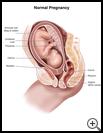
Types of Baby Movements
________________________________________________________________________
KEY POINTS
- About halfway through a pregnancy, the first movements that a woman feels are called quickening.
- Your baby makes many other movements that you may not feel. The smaller the movement is, the less likely you are to feel it.
- If you feel that your baby is moving less than usual, call your healthcare provider right away.
________________________________________________________________________
What are normal baby movements?
Babies start to move very early in pregnancy, but most women don’t feel the movements until about halfway through the pregnancy. The first movements that a woman feels are called quickening.
Every baby has its own pattern of movements. You may feel several kinds of normal baby movements during the last half of your pregnancy. The pattern of movements may change as your baby grows and has less space to move around.
You may feel the baby turn from one side of your abdomen to the other. When your baby turns, your abdomen may feel hard when it is pushed out by your baby’s back. You might also feel kicking movements underneath your ribs. The baby’s kicks can become quite strong near your due date and can be very uncomfortable. You may also notice that your baby starts kicking in response to loud noises or music. Just remember that regular movements are normal.
Sometimes you may feel a quick bumping movement every few seconds. These fast bumps are probably hiccups and are normal. The baby’s hiccups can be so strong that you may be able to see your abdomen moving.
Your baby also makes many other movements that you may not feel, such as practice breathing, blinking, bending or stretching arms and legs, waving, turning, or rolling. The smaller the movement is, the less likely you are to feel it.
What should I watch out for?
If you have questions about your baby’s movements, talk to your health care provider at your next appointment. If you feel that your baby is moving less than usual, call your healthcare provider right away.

